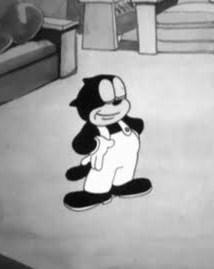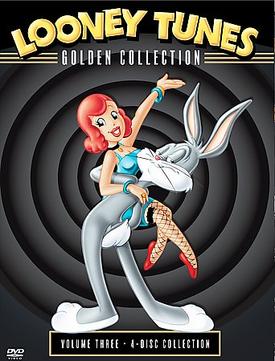
Looney Tunes is an American animated franchise produced and distributed by Warner Bros. It began as a series of short films that originally ran from 1930 to 1969, concurrently with its partner series Merrie Melodies, during the golden age of American animation. Following a revival in the late 1970s, new shorts were released as recently as 2014. The two series introduced a large cast of characters, including Bugs Bunny, Daffy Duck, and Porky Pig. The term Looney Tunes has since been expanded to also refer to the characters themselves.
This is a listing of the shorts, feature films, television programs, and television specials in the Looney Tunes and Merrie Melodies cartoon series, extending from 1929 through the present day. Altogether, 1,002 animated shorts alone were released under the Looney Tunes and Merrie Melodies banners from the 1930s through the 1960s. From the beginning to the present day, 1,041 theatrical shorts have been created.

Merrie Melodies is an American animated comedy short film series distributed by Warner Bros. Pictures. It is the companion series to Looney Tunes, and featured many of the same characters as the former series. It originally ran from August 2, 1931, to September 20, 1969, during the golden age of American animation, though it had been revived in 1979, with new shorts sporadically released until June 13, 1997. Originally, Merrie Melodies placed emphasis on one-shot color films in comparison to the black and white Looney Tunes films. After Bugs Bunny became the breakout character of Merrie Melodies and Looney Tunes transitioned to color production in the early 1940s, the two series gradually lost their distinctions and shorts were assigned to each series randomly.

Petunia Pig is an animated cartoon character in the Looney Tunes and Merrie Melodies series of cartoons from Warner Bros. She looks much like her significant other, Porky Pig, except that she wears a dress and has pigtailed black hair.

Beans the Cat is an animated cartoon character in the Warner Bros. Cartoons series of cartoons from 1935–1936. Beans was the third Warner Bros cartoon character star after Bosko and Buddy. He is voiced by Billy Bletcher and occasionally by Tommy Bond. He was created by director Friz Freleng. The character was featured in nine cartoons made in 1935 and 1936.

I Haven't Got a Hat is a 1935 animated short film, directed by Isadore Freleng for Leon Schlesinger Productions as part of the Merrie Melodies series. Released on March 2, 1935, the short is notable for featuring the first appearance of several Warner Bros. cartoon characters, most notably future cartoon star Porky Pig. Beans the Cat, a minor Looney Tunes star in 1935-1936, also made his first appearance in this cartoon.

A Wild Hare is a 1940 American animated comedy short film directed by Tex Avery, produced by Leon Schlesinger, and distributed by Warner Bros. as part of the Merrie Melodies series. The film was released on July 27, 1940, and features Elmer Fudd and Bugs Bunny, the latter making what is considered his first official appearance.

I Love to Singa is a 1936 Warner Bros. Merrie Melodies animated cartoon directed by Tex Avery. The short was released on July 18, 1936.
Robert Cameron Bruce Jr. was an American voice actor and the son of Robert Cameron Bruce (1887–1948) who was a cinematographer and documentary producer. He was the narrator for a number of Warner Bros. cartoons in the 1930s and 1940s. The Looney Tunes and Merrie Melodies series' had occasional entries which were driven not by one of their stable of stars such as Bugs Bunny or Daffy Duck, but by individual short sketches, usually filled with sight gags and word-play. Later he was a writer and producer of industrial motion pictures based in Minnesota.

Looney Tunes Golden Collection: Volume 5 is a Looney Tunes collection on DVD. Following the pattern of one release each year of the previous volumes, it was released on October 30, 2007.

The Mouse That Jack Built is a 1959 Warner Bros. Merrie Melodie cartoon short starring Jack Benny and the regular cast of The Jack Benny Program as mice. The short, released on April 4, 1959, was written by Tedd Pierce and directed by Robert McKimson.
Warner Bros.' library of Oscar-nominated cartoons were showcased in a DVD set released by Warner Home Video on February 12, 2008 that included their own Looney Tunes and Merrie Melodies, as well as Tom and Jerry, Droopy, and other classic MGM cartoons, together with entries from Max Fleischer's Popeye and Superman series. All cartoons selected for this release were nominated for the Academy Award for Best Animated Short Film, with the exception of the film So Much for So Little, which won the Academy Award for Documentary Short Subject. A total of 41 cartoons were chosen for this set, 15 of them being Oscar winners.
The Cat Came Back is a 1936 Warner Bros. Merrie Melodies cartoon directed by Friz Freleng. The short was released on February 8, 1936.

Looney Tunes Golden Collection: Volume 3 is a DVD box set from Warner Home Video that was released on October 25, 2005. It contains 60 Looney Tunes and Merrie Melodies theatrical short subject cartoons, nine documentaries, 32 commentary tracks from animators and historians, 11 "vintage treasures from the vault", and 11 music-only or music-and-sound-effects audio tracks.

Hamateur Night is a 1939 Warner Bros. Merrie Melodies cartoon directed by Tex Avery and written by Jack Miller. The short was released on January 28, 1939 and features an early version of Elmer Fudd.
The Hardship of Miles Standish is a 1940 Merrie Melodies cartoon directed by Friz Freleng. The short was released on April 27, 1940, and features Elmer Fudd.
Sniffles Takes a Trip is a 1940 Warner Bros. Merrie Melodies cartoon directed by Chuck Jones. The short was released on May 22, 1940, and stars Sniffles the mouse.
The Egg Collector is a 1940 Warner Bros. Merrie Melodies directed by Chuck Jones. The short was released on July 20, 1940, and stars Sniffles.

The Bear's Tale is a 1940 Warner Bros. Merrie Melodies animated cartoon short, directed by Tex Avery. The short was released on April 13, 1940, and stars the Three Bears.

Little Pancho Vanilla is a 1938 Warner Bros. Merrie Melodies cartoon directed by Frank Tashlin, with story by Tedd Pierce. The short was released on October 8, 1938.












